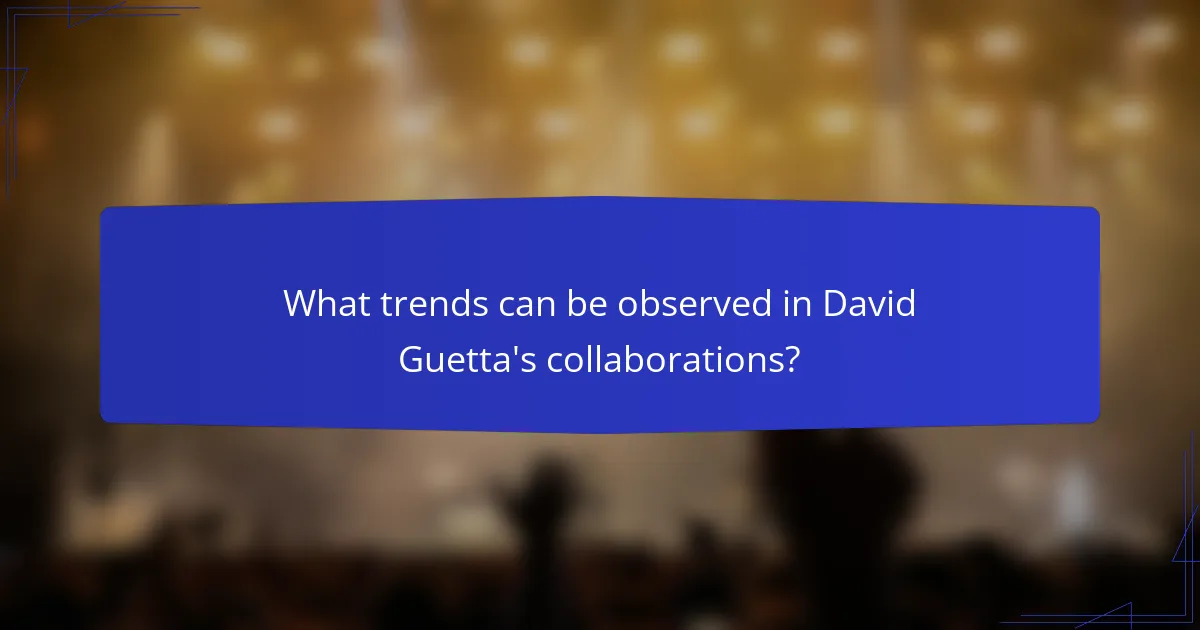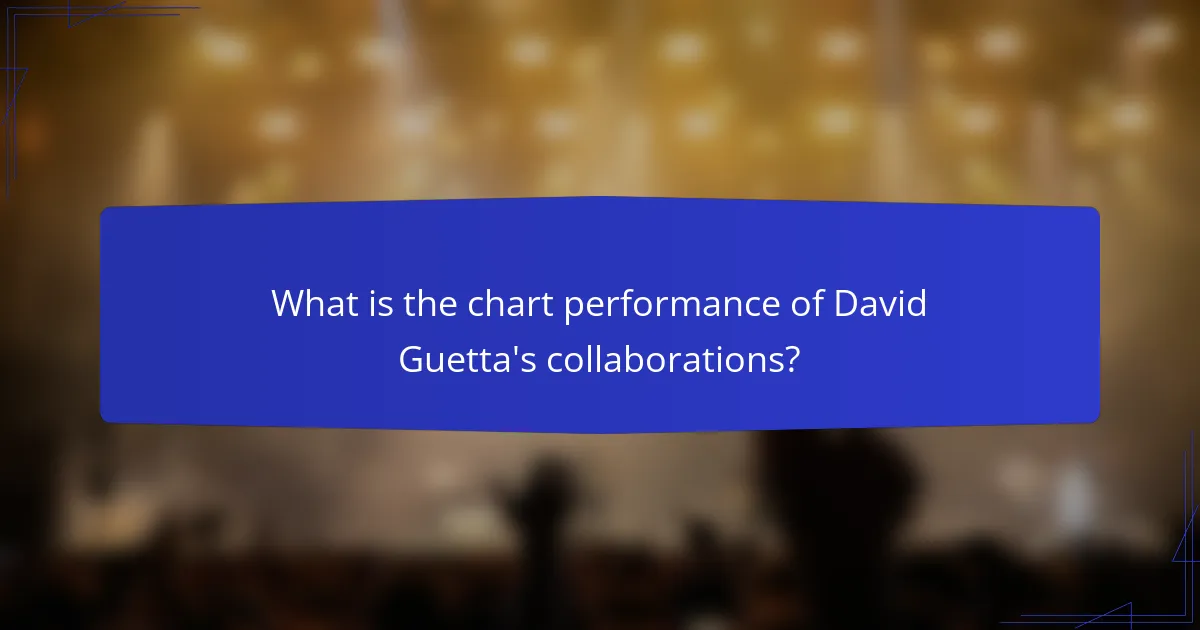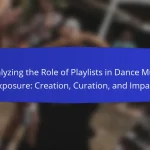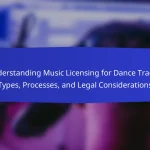David Guetta is a prominent music producer known for his impactful collaborations across various genres. This article examines Guetta’s most iconic partnerships, including successful tracks like “Titanium” with Sia, “When Love Takes Over” featuring Kelly Rowland, and “Without You” with Usher. It highlights his ability to blend pop, hip-hop, and electronic dance music, resulting in chart-topping hits that appeal to a wide audience. The article also discusses the commercial success and awards associated with Guetta’s collaborations, underscoring his significant influence in the music industry.
![]()
What are David Guetta’s most iconic collaborations?
David Guetta’s most iconic collaborations include tracks with artists like Sia, Nicki Minaj, and Usher. The song “Titanium,” featuring Sia, reached high positions in global charts. It showcased Guetta’s signature electro-pop sound. Another notable collaboration is “When Love Takes Over” with Kelly Rowland. This track won a Grammy Award and topped charts in multiple countries. Guetta also worked with Usher on “Without You,” which became a commercial success. His collaboration with Nicki Minaj on “Turn Me On” further solidified his influence in the dance music scene. These collaborations highlight Guetta’s ability to blend genres and create chart-topping hits.
How have these collaborations shaped his career?
David Guetta’s collaborations have significantly shaped his career by expanding his musical reach and influence. These partnerships have introduced him to diverse audiences across various genres. Collaborating with artists like Sia and Usher has led to chart-topping hits, enhancing his visibility. For instance, “Titanium” featuring Sia became a global anthem, solidifying his status in electronic music. Additionally, his work with hip-hop and pop artists has blended genres, attracting a wider fan base. This strategic collaboration approach has resulted in multiple Grammy nominations and awards. Overall, these collaborations have been pivotal in establishing David Guetta as a leading figure in the music industry.
What are the key attributes of these collaborations?
The key attributes of David Guetta’s collaborations include genre diversity, high-profile artists, and chart success. Guetta collaborates across various genres, including pop, hip-hop, and electronic dance music. This diversity allows him to reach a broad audience. He frequently partners with high-profile artists, enhancing the visibility and appeal of his tracks. Collaborations often lead to significant chart performance, with many singles achieving high positions on global music charts. For instance, his track “Titanium” featuring Sia reached the top 10 in multiple countries. These attributes contribute to the lasting impact and popularity of his collaborations in the music industry.
How do these collaborations reflect David Guetta’s musical evolution?
David Guetta’s collaborations reflect his musical evolution by showcasing his adaptability to changing trends. Over the years, he has partnered with diverse artists across genres. This includes pop, hip-hop, and electronic music. For instance, his work with artists like Sia on “Titanium” marked a shift towards more emotive and vocal-driven tracks. Collaborations with hip-hop artists such as Nicki Minaj and Lil Wayne highlight his integration of urban influences. These partnerships have expanded his sound and audience reach. Additionally, his recent collaborations with emerging artists indicate a willingness to embrace new styles. This evolution is evident in his chart performance, consistently achieving high rankings across various music platforms.
What styles and genres are prevalent in David Guetta’s collaborations?
David Guetta’s collaborations predominantly feature electronic dance music (EDM) styles, including house, progressive house, and electro house. He often blends these genres with pop, hip-hop, and R&B elements. Notable tracks like “Titanium” with Sia showcase his ability to merge EDM with powerful vocal performances. His work with artists such as Nicki Minaj and Usher highlights his versatility in incorporating mainstream pop and hip-hop influences. Guetta’s collaborations have consistently topped charts, reflecting the widespread appeal of these genres. His innovative fusion of styles has played a significant role in shaping contemporary dance music trends.
How do different genres influence the sound of his tracks?
Different genres significantly influence the sound of David Guetta’s tracks. Guetta blends elements from electronic dance music, pop, hip-hop, and house. Each genre brings distinct characteristics to his productions. For example, pop influences contribute catchy melodies and hooks. Hip-hop elements add rhythmic complexity and lyrical depth. House music provides a strong beat and danceable grooves. Guetta’s collaborations often reflect these genre fusions. This versatility allows him to appeal to a broader audience. His tracks frequently chart across multiple music genres, showcasing this influence.
What are the unique attributes of his collaborations across genres?
David Guetta’s collaborations across genres feature a blend of electronic dance music with pop, hip-hop, and R&B elements. Each collaboration showcases his ability to merge diverse musical styles seamlessly. He often works with a wide range of artists, including both established stars and emerging talents. This approach broadens his audience appeal and enhances the dynamism of his tracks. Guetta’s collaborations frequently result in chart-topping hits, demonstrating commercial success across various music charts. His innovative production techniques contribute to the unique sound of each collaboration. Additionally, he adapts his musical style to complement the distinct characteristics of each featured artist. This flexibility allows for a fresh take on genre conventions, making his work stand out in the music industry.

What trends can be observed in David Guetta’s collaborations?
David Guetta’s collaborations often feature a blend of pop, hip-hop, and electronic dance music. He frequently partners with vocalists and artists from diverse genres. This trend enhances his music’s mainstream appeal. Collaborations with artists like Sia and Nicki Minaj have led to chart-topping hits. Guetta’s work typically emphasizes catchy hooks and anthemic choruses. He often collaborates with emerging artists alongside established stars. This approach helps to introduce fresh talent to a wider audience. His collaborations consistently achieve significant commercial success, reflecting his influence in the music industry.
How have musical trends influenced his collaborative choices?
Musical trends have significantly influenced David Guetta’s collaborative choices. He adapts to evolving genres like EDM, pop, and hip-hop. This adaptability allows him to remain relevant in the music industry. For example, his collaborations with artists like Sia and Nicki Minaj align with mainstream pop trends. Guetta often collaborates with emerging artists to tap into new sounds. This strategy enhances his appeal to diverse audiences. Additionally, he has embraced global music trends, incorporating influences from various cultures. His work reflects the changing landscape of popular music, ensuring continued chart success.
What role does technology play in shaping these collaborations?
Technology plays a crucial role in shaping collaborations in the music industry. It enables artists to connect across geographical boundaries. Digital platforms facilitate real-time communication and idea sharing. Collaborative tools allow for seamless production and editing of tracks. Streaming services provide instant access to a global audience. Social media enhances promotional strategies and fan engagement. Data analytics offers insights into listener preferences and trends. These technological advancements have transformed how artists like David Guetta collaborate and reach their audiences effectively.
How do cultural trends impact the themes of his collaborations?
Cultural trends significantly shape the themes of David Guetta’s collaborations. They influence the musical styles he adopts and the messages conveyed in his work. For instance, during the rise of electronic dance music, Guetta embraced upbeat and energetic themes. This alignment with popular culture helped his tracks resonate with wider audiences. Additionally, social movements and global events often inspire the lyrical content of his collaborations. For example, themes of unity and empowerment emerged in response to societal changes. Guetta’s work reflects current cultural sentiments, making it relevant and appealing. This adaptability contributes to his sustained success in the music industry.
What are the common characteristics of successful collaborations with David Guetta?
Successful collaborations with David Guetta often feature a blend of catchy melodies and strong vocal performances. These collaborations typically include a mix of electronic and pop genres. Collaborators often bring unique styles, enhancing the final product. High production quality is a hallmark of Guetta’s work, ensuring a polished sound. Many successful tracks showcase relatable lyrics that resonate with a wide audience. Chart performance often reflects the commercial appeal of these collaborations. Collaborations frequently leverage social media for promotion, maximizing reach. Notable partnerships include artists like Sia and Nicki Minaj, who have contributed to chart-topping hits.
What attributes contribute to chart-topping success?
Catchy melodies and relatable lyrics contribute to chart-topping success. These attributes resonate with a wide audience, increasing listener engagement. Strong production quality enhances the overall sound, making tracks more appealing. Collaborations with popular artists can broaden reach and attract diverse fan bases. Effective marketing strategies, including social media promotion, play a crucial role in visibility. Timing of release can also impact success, aligning with trends or seasonal events. Historical data shows that songs with these attributes often dominate charts, such as those from artists like David Guetta.
How do artist partnerships enhance the appeal of his music?
Artist partnerships enhance the appeal of David Guetta’s music by introducing diverse sounds and styles. Collaborations with various artists attract their fan bases, expanding his audience reach. Unique vocal performances and songwriting contribute to fresh musical experiences. These partnerships often result in chart-topping hits, increasing commercial success. For instance, his collaboration with Sia on “Titanium” became a global anthem. Such tracks frequently receive extensive radio play and streaming, further boosting popularity. Overall, artist collaborations create a dynamic synergy that elevates the quality and marketability of his music.

What is the chart performance of David Guetta’s collaborations?
David Guetta’s collaborations have consistently performed well on music charts worldwide. Many of his tracks have reached the top positions in various countries. For instance, “Titanium” featuring Sia peaked at number one in several countries, including Belgium and the Netherlands. Another notable collaboration, “When Love Takes Over” with Kelly Rowland, also topped charts in multiple regions, including the UK. Additionally, “Play Hard” featuring Ne-Yo and Akon reached the top ten in several countries, showcasing Guetta’s widespread appeal. His work has earned numerous awards, further solidifying his status in the music industry.
How do his collaborations rank in global music charts?
David Guetta’s collaborations frequently achieve high rankings in global music charts. Many of his tracks have reached the top positions on the Billboard Hot 100 and the UK Singles Chart. For instance, his collaboration with Sia on “Titanium” peaked at number 7 on the Billboard Hot 100. Additionally, “When Love Takes Over,” featuring Kelly Rowland, reached number 1 in multiple countries. Guetta’s work with artists like Nicki Minaj and Usher has also led to significant chart success. His collaborations often blend genres, appealing to a broad audience and enhancing their chart performance.
What factors contribute to the chart success of his tracks?
The chart success of David Guetta’s tracks is influenced by multiple factors. Collaborations with popular artists enhance visibility and appeal. Catchy melodies and strong hooks attract listeners and encourage repeat plays. Genre-blending styles appeal to a wider audience, increasing streaming and sales. Strategic marketing and promotion boost track exposure across platforms. Timely releases aligned with seasonal trends can maximize listener engagement. Additionally, high production quality ensures a polished sound that resonates with fans. Social media presence and fan engagement amplify track reach and impact. These elements collectively contribute to the commercial performance of his music.
How do collaborations with different artists affect chart performance?
Collaborations with different artists significantly enhance chart performance. They combine fan bases, increasing audience reach. For instance, David Guetta’s collaborations with artists like Sia and Nicki Minaj led to multiple chart-topping hits. The song “Titanium,” featuring Sia, peaked at number one in several countries. Collaborative tracks often generate more promotional opportunities, including live performances and media appearances. This increased visibility can lead to higher streaming numbers and sales. Additionally, collaborations can infuse diverse musical styles, appealing to broader demographics. The combined star power often results in more impactful marketing campaigns. Overall, collaborations create synergy that can elevate a song’s success on music charts.
What insights can be gained from analyzing David Guetta’s collaboration trends?
Analyzing David Guetta’s collaboration trends reveals his strategic partnerships and genre versatility. Guetta frequently collaborates with diverse artists, enhancing his musical range. His collaborations often blend electronic dance music with pop, hip-hop, and R&B. This approach broadens his audience appeal and maintains chart performance. For instance, tracks like “Titanium” with Sia and “When Love Takes Over” with Kelly Rowland achieved significant commercial success. These collaborations showcase his ability to fuse different musical styles effectively. Additionally, Guetta’s trend of working with emerging artists indicates his commitment to innovation in the music industry.
How can emerging artists learn from his collaborative approach?
Emerging artists can learn from David Guetta’s collaborative approach by understanding the importance of partnerships. Guetta frequently collaborates with diverse artists across genres. This strategy broadens his audience reach and enhances creativity. Collaborations often lead to innovative sounds that attract listeners. Guetta’s work with artists like Sia and Nicki Minaj showcases successful genre blending. By observing these partnerships, emerging artists can identify potential collaborators in their networks. They can also learn to adapt their style to complement others. This adaptability can result in unique music that resonates with wider audiences. Ultimately, collaboration can be a key factor in achieving commercial success.
What best practices can be applied from his successful collaborations?
Effective communication is a best practice from David Guetta’s successful collaborations. Clear dialogue fosters creativity and aligns visions among collaborators. Establishing mutual respect is crucial for productive partnerships. This encourages open sharing of ideas and constructive feedback. Flexibility in collaboration allows for adaptability to new styles and trends. Guetta often embraces diverse musical influences, enhancing his work’s appeal. Setting clear goals and expectations leads to focused efforts and measurable success. This approach has contributed to numerous chart-topping hits in his career. Lastly, leveraging technology for remote collaboration has expanded his reach and facilitated partnerships globally.
David Guetta is a prominent figure in the music industry, known for his iconic collaborations with artists such as Sia, Nicki Minaj, and Usher. This article examines the key attributes of Guetta’s collaborations, including genre diversity, chart performance, and the influence of cultural trends on his music. It highlights how these partnerships have shaped his career, showcasing his adaptability and the successful blending of electronic dance music with pop and hip-hop elements. Additionally, the article explores the role of technology and effective communication in enhancing the appeal and success of his collaborative works.

